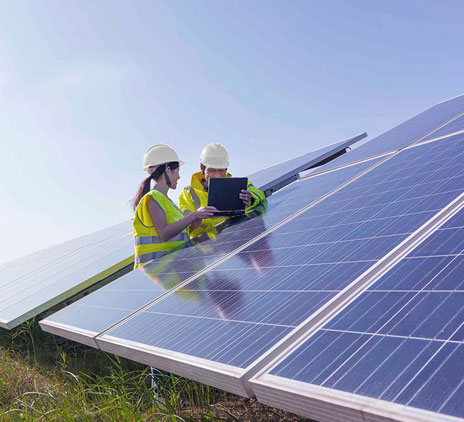- Market services
-
Compliance audits & reviews
Our audit team undertakes the complete range of audits required of Australian accounting laws to help you to help you meet obligations or fulfil best practice procedures.
-
Audit quality
We are fiercely dedicated to quality, use proven and globally tested audit methodologies, and invest in technology and innovation.
-
Financial reporting advisory
Our financial reporting advisory team helps you understand changes in accounting standards, develop strategies and communicate with your stakeholders.
-
Audit advisory
Grant Thornton’s audit advisory team works alongside our clients, providing a full range of reviews and audits required of your business.
-
Digital assurance
We capture actionable, quality insights from data within your financial reporting and auditing processes.

-
Corporate tax & advisory
We provide comprehensive corporate tax and advisory service across the full spectrum of the corporate tax process.
-
Private business tax & advisory
We work with private businesses and their leaders on all their business tax and advisory needs.
-
Tax compliance
We work alongside clients to manage all tax compliance needs and identify potential compliance or tax risk issues.
-
Employment tax
We help clients understand and address their employment tax obligations to ensure compliance and optimal tax positioning for their business and employees.
-
International tax
We understand what it means to manage tax issues across multiple jurisdictions, and create effective strategies to address complex challenges.
-
GST, stamp duty & indirect tax
Our deep technical knowledge and practical experience means we can help you manage and minimise the impact of GST and indirect tax, like stamp duty.
-
Tax law
Our team – which includes tax lawyers – helps you understand and implement regulatory requirements for your business.
-
Innovation Incentives
Our national team has extensive experience navigating all aspects of the government grants and research and development tax incentives.
-
Transfer pricing
Transfer pricing is one of the most challenging tax issues. We help clients with all their transfer pricing requirements.
-
Tax digital consulting
We analyse high-volume and unstructured data from multiple sources from our clients to give them actionable insights for complex business problems.
-
Corporate simplification
We provide corporate simplification and managed wind-down advice to help streamline and further improve your business.
-
Superannuation and SMSF
Increasingly, Australians are seeing the benefits, advantages and flexibility of taking control of their own superannuation and retirement planning.

-
Payroll consulting & Award compliance
Many organisations are grappling with a myriad of employee agreements and obligations, resulting in a wide variety of payments to their people.
-
Cyber resilience
The spectrum of cyber risks and threats is now so significant that simply addressing cybersecurity on its own isn’t enough.
-
Internal audit
We provide independent oversight and review of your organisation's control environments to manage key risks, inform good decision-making and improve performance.
-
Financial crime
Our team helps clients navigate and meet their obligations to mitigate crime as well as develop and implement their risk management strategies.
-
Consumer Data Right
Consumer Data Right (CDR) aims to provide Australians with more control over how their data is used and disclosed.
-
Risk management
We enable our clients to achieve their strategic objectives, fulfil their purpose and live their values supported by effective and appropriate risk management.
-
Controls assurance
In Australia, as with other developed economies, regulatory and market expectations regarding corporate transparency continue to increase.
-
Governance
Through fit for purpose governance we enable our clients to make the appropriate decisions on a timely basis.
-
Regulatory compliance
We enable our clients to navigate and meet their regulatory and compliance obligations.

-
Forensic accounting and dispute advisory
Our team advises at all stages of a litigation dispute, taking an independent view while gathering and reviewing evidence and contributing to expert reports.
-
Investigations
Our licensed forensic investigators with domestic and international experience deliver high quality results in the jurisdictions in which you operate.
-
Asset tracing investigations
Our team of specialist forensic accountants and investigators have extensive experience in tracing assets and the flow of funds.

-
Mergers and acquisitions
Our mergers and acquisitions specialists guide you through the whole process to get the deal done and lay the groundwork for long-term success.
-
Acquisition search & strategy
We help clients identify, finance, perform due diligence and execute acquisitions to maximise the growth opportunities of your business.
-
Selling a business
Our M&A team works with clients to achieve a full or partial sale of their business, to ensure achievement of strategic ambitions and optimal outcomes for stakeholders.
-
Operational deal services
Our operational deal services team helps to ensure the greatest possible outcome and value is gained through post merger integration or post acquisition integration.
-
Transaction advisory
Our transaction advisory services support our clients to make informed investment decisions through robust financial due diligence.
-
ESG Due Diligence
Our ESG due diligence process evaluates a company's environmental, social, and governance factors during the pre-investment phase to determine the overall maturity of the entity, manage potential risks, and identify opportunities.
-
Business valuations
We use our expertise and unique and in-depth methodology to undertake business valuations to help clients meet strategic goals.
-
Tax in mergers & acquisition
We provide expert advice for all M&A taxation aspects to ensure you meet all obligations and are optimally positioned.

-
Corporate finance
We provide effective and strategic corporate finance services across all stages of investments and transactions so clients can better manage costs and maximise returns.
-
Debt advisory
We work closely with clients and lenders to provide holistic debt advisory services so you can raise or manage existing debt to meet your strategic goals.
-
Working capital optimisation
Our proven methodology identifies opportunities to improve your processes and optimise working capital, and we work with to implement changes and monitor their effectiveness.
-
Capital markets
Our team has significant experience in capital markets and helps across every phase of the IPO process.
-
Debt and project finance raising
Backed by our experience accessing full range of available funding types, we work with clients to develop and implement capital raising strategies.
-
Private equity
We provide advice in accessing private equity capital.
-
Financial modelling
Our financial modelling advisory team provides strategic, economic, financial and valuation advice for project types and sizes.
-
Payments advisory
We provide merchants-focused payments advice on all aspects of payment processes and technologies.

-
Voluntary administration & DOCA
We help businesses considering or in voluntary administration to achieve best possible outcomes.
-
Corporate insolvency & liquidation
We help clients facing corporate insolvency to undertake the liquidation process to achieve a fair and orderly company wind up.
-
Complex and international insolvency
As corporate finance specialists, Grant Thornton can help you with raising equity, listings, corporate structuring and compliance.
-
Safe Harbour advisory
Our Safe Harbour Advisory helps directors address requirements for Safe Harbour protection and business turnaround.
-
Bankruptcy and personal insolvency
We help clients make informed choices around bankruptcy and personal insolvency to ensure the best personal and stakeholder outcome.
-
Creditor advisory services
Our credit advisory services team works provides clients with credit management assistance and credit advice to recapture otherwise lost value.
-
Small business restructuring process
We provide expert advice and guidance for businesses that may need to enter or are currently in small business restructuring process.
-
Asset tracing investigations
Our team of specialist forensic accountants and investigators have extensive experience in tracing assets and the flow of funds.

-
Independent business reviews
Does your company need a health check? Grant Thornton’s expert team can help you get to the heart of your issues to drive sustainable growth.
-
Commercial performance
We help clients improve commercial performance, profitability and address challenges after internal or external triggers require a major business model shift.
-
Safe Harbour advisory
Our Safe Harbour advisory helps directors address requirements for Safe Harbour protection and business turnaround.
-
Corporate simplification
We provide corporate simplification and managed wind-down advice to help streamline and further improve your business.
-
Director advisory services
We provide strategic director advisory services in times of business distress to help directors navigate issues and protect their company and themselves from liability.
-
Debt advisory
We work closely with clients and lenders to provide holistic debt advisory services so you can raise or manage existing debt to meet your strategic goals.

-
Business planning & strategy
Our clients can access business planning and strategy advice through our value add business strategy sessions.
-
Private business company secretarial services
We provide company secretarial services and expert advice for private businesses on all company secretarial matters.
-
Outsourced accounting services
We act as a third-party partner to international businesses looking to invest in Australia on your day-to-day finance and accounting needs.
-
Superannuation and SMSF
We provide SMSF advisory services across all aspects of superannuation and associated tax laws to help you protect and grow your wealth.
-
Management reporting
We help you build comprehensive management reporting so that you have key insights as your business grows and changes.
-
Financial reporting
We help with all financial reporting needs, including set up, scaling up, spotting issues and improving efficiency.
-
Forecasting & budgeting
We help you build and maintain a business forecasting and budgeting model for ongoing insights about your business.
-
ATO audit support
Our team of experts provide ATO audit support across the whole process to ensure ATO requirements are met.
-
Family business consulting
Our family business consulting team works with family businesses on running their businesses for continued future success.
-
Private business taxation and structuring
We help private business leaders efficiently structure their organisation for optimal operation and tax compliance.
-
Outsourced CFO services
Our outsourced CFO services provide a full suite of CFO, tax and finance services and advice to help clients manage risk, optimise operations and grow.
-
ESG, sustainability and climate reporting
There is a growing demand for organisations to provide transparency on their commitment to sustainability and disclosure of the nonfinancial impacts of their business activities. Commonly, the responsibility for sustainability and ESG reporting is landing with CFOs and finance teams, requiring a reassessment of a range of reporting processes and controls.
-
ESG, sustainability and climate advisory
With the ESG and sustainability landscape continuing to evolve, we are focussed on helping your business to understand what ESG and sustainability represents and the opportunities and challenges it can provide.
-
ESG, sustainability and climate reporting assurance
As the demand for organisations to prepare information in relation to ESG & sustainability continues to increase, through changes in regulatory requirements or stakeholder expectations, there is a growing need for assurance over the information prepared.
-
ESG and sustainability due diligence
As environmental, social, and governance (ESG) considerations become increasingly pivotal for dealmakers in Australia, it is important for investors to feel confident in assessing transactions through an ESG lens.

-
Management consulting
Our management consulting services team helps you to plan and implement the right strategy to deliver sustainable growth.
-
Financial consulting
We provide financial consulting services to keep your business running so you focus on your clients and reaching strategic goals.

-
China practice
The investment opportunities between Australia and China are well established yet, in recent years, have also diversified.
-
Japan practice
The trading partnership between Japan and Australia is long-standing and increasingly important to both countries’ economies.
-
India practice
It’s an exciting time for Indian and Australian businesses looking to each jurisdiction as part of their growth ambitions.
-
Singapore practice
Our Singapore Practice works alongside Singaporean companies to achieve growth through investment and market expansion into Australia.
-
Vietnam practice
Investment and business opportunities in Vietnam are expanding rapidly, driven by new markets, diverse industries, and Vietnam's growing role in export manufacturing, foreign investment, and strong domestic demand.

-
 Client Alert Wine not? Primary production land tax exemption no longer on the vineFor wine producers and vineyard owners, the recent New South Wales Civil and Administrative Tribunal decision in Zonadi Holdings Pty Ltd ATF Wombat Investment Trust v Chief Commissioner of State Revenue [2025] NSWCATAD 84 may spell trouble for their current primary production land tax exemptions.
Client Alert Wine not? Primary production land tax exemption no longer on the vineFor wine producers and vineyard owners, the recent New South Wales Civil and Administrative Tribunal decision in Zonadi Holdings Pty Ltd ATF Wombat Investment Trust v Chief Commissioner of State Revenue [2025] NSWCATAD 84 may spell trouble for their current primary production land tax exemptions. -
 Client Alert Unlock 2025: government grants updateIf government grants are part of your 2025 strategy, take note of the available quarter one funding opportunities. With increasing inflationary pressures, government grants can be an essential alternative funding source for businesses with critical investment projects.
Client Alert Unlock 2025: government grants updateIf government grants are part of your 2025 strategy, take note of the available quarter one funding opportunities. With increasing inflationary pressures, government grants can be an essential alternative funding source for businesses with critical investment projects. -
 Report Agribusiness, Food & Beverage Dealtracker 2024Merger & Acquisition (M&A) and equity market activity in the Agribusiness, Food & Beverage (Ag, F&B) sector is undergoing a strategic shift, as investors have become more selective and increasingly cautious in response to global economic uncertainty.
Report Agribusiness, Food & Beverage Dealtracker 2024Merger & Acquisition (M&A) and equity market activity in the Agribusiness, Food & Beverage (Ag, F&B) sector is undergoing a strategic shift, as investors have become more selective and increasingly cautious in response to global economic uncertainty. -
 Client Alert Government Grants in FY25As we embark on a new financial year, it’s crucial to take a strategic approach to understanding the government grants landscape.
Client Alert Government Grants in FY25As we embark on a new financial year, it’s crucial to take a strategic approach to understanding the government grants landscape.
-
Renewable Energy
Transformation through energy transition

-
Flexibility & benefits
The compelling client experience we’re passionate about creating at Grant Thornton can only be achieved through our people. We’ll encourage you to influence how, when and where you work, and take control of your time.
-
Your career development
At Grant Thornton, we strive to create a culture of continuous learning and growth. Throughout every stage of your career, you’ll to be encouraged and supported to seize opportunities and reach your full potential.
-
Diversity & inclusion
To be able to reach your remarkable, we understand that you need to feel connected and respected as your authentic self – so we listen and strive for deeper understanding of what belonging means.
-
In the community
We’re passionate about making a difference in our communities. Through our sustainability and community engagement initiatives, we aim to contribute to society by creating lasting benefits that empower others to thrive.
-
Graduate opportunities
As a new graduate, we aim to provide you more than just your ‘traditional’ graduate program; instead we kick start your career as an Associate and support you to turn theory into practice.
-
Vacation program
Our vacation experience program will give you the opportunity to begin your career well before you finish your degree.
-
The application process
Applying is simple! Find out more about each stage of the recruitment process here.
-
FAQs
Got questions about applying? Explore frequently asked questions about our early careers programs.
-
Our services lines
Learn about our services at Grant Thornton
-
Current opportunities
Current opportunities
-
Remarkable people
Our team members share their remarkable career journeys and experiences of working at Grant Thornton.
-
Working at Grant Thornton
Explore our culture, benefits and ways we support you in your career.
-
Current opportunities
Positions available.
-
Contact us
Get in touch

Ahead of the Federal Budget on 25 October, we published our insights on Transforming Australia’s renewable energy sector. In this article, we highlighted the need to not only increase the pace of renewable energy developments but for it to be undertaken in the right way, supported by realistic policy to combat the sectors challenges and restore investor and consumer confidence.
Will the current renewable energy pipeline meet demand?
According to the AEMO in its 2022 Electricity Statement of Opportunities (ESOO) Report the reliability of the National Electricity Market (NEM) over the next decade is going to fall short unless the right projects are progressed quickly. The NEM currently generates 59.6 gigawatts (GW) of electricity (February 2022), with fossil fuels accounting for a significant portion of this (71 per cent in 2021). Coal and thermal energy power plants have a typical lifespan of around 30 years, and the first group of coal-generation retirements will occur over the next 7 years with five plants expecting to close reducing energy supply by around 8.3GW. So how will this gap not only be filled, but exceeded to factor in future retirements?
The 2022 ESOO shows 8.6GW of committed generation projects which meet AEMO’s criteria, are under construction and with operations beginning after 1 July 2024. There is a further 3.4GW of anticipated generation which meets some of AEMO’s commitment criteria, but not enough criteria to be considered “committed”. The reliability forecast improves with this 3.4GW when considered alongside the developments identified in AEMO’s 2022 Integrated System Plan (ISP). Assuming schedules are kept then reliability in all regions of the NEM will be met until other thermal generators are retired.
There is also a pipeline of 165GW of publicly announced (proposed) projects, with the majority of these in New South Wales. Over 68 per cent are renewable energy generation projects and over 26 per cent are storage projects (battery or pumped hydro). So, what has Labor committed to and is investment going to the right projects?
The Federal Budget’s $20b+ injection to aid the supply and demand challenge
The Budget outlined what Labor said it would do, further demonstrating the new government’s commitment to clean energy with a medium to long term view. The Budget included close to $25b to support the push to cut carbon emissions by 43 per cent by 2030.
The majority – $20b – will support the already announced Rewiring the Nation transmission upgrade initiative, needed to accommodate new and future projects with reliable grid connections in the right places. This will be done in part through investment into interconnector projects such as the Marinus Link project and the Victoria to New South Wales Interconnector West Project (VNI-West) to support Tasmania’s Battery of the Nation and Victoria’s offshore wind and renewables industries and linking renewable energy zones to the existing grid at low cost. The AEMO designated both projects as critical investments in its ISP to cope with the exit of fossil fuel generation projects.
The Australian Renewable Energy Agency (ARENA) and the Clean Energy Finance Corporation (CEFC) will both have their funding maintained. The CEFC will be the finance arm of the new Rewiring the Nation Office, with AEMO as a technical advisor
The Australian Energy Regulator (AER) also received $22.8m of support to help integrate more renewable energy into the NEM and improve the regulation of gas pipelines to lower transportation costs and promote reliable supply.
Other Budget investments include:
- $1.9b Powering the Regions Fund to transition regional industries to net zero and support new jobs. It will continue the purchase of Australian Carbon Credit Units and support the generation of carbon offsets in Australia. Labor will undertake and independent review of the integrity of Australian Carbon Credit Units as part of its focus on strengthening Australia’s carbon markets
- $275m to deliver the $500m Driving the Nation Fund to help reduce transport emissions, including delivery of electric vehicle charging infrastructure
- $224.3m for the Community Batteries for Household Solar grants program, to deploy 400 community batteries across Australia
- $157.9m to support the implementation of the National Energy Transformation Partnership to support Federal, State and Territory governments working together on priority actions and other energy security and reliability measures
- $102.2m to establish a Community Solar Banks program for the deployment of community-scale solar and clean energy technologies
- $71.9 million to build a Hydrogen Hub in Townsville, to fast-track Australia’s green hydrogen industry
- $40.9m in increased oversight of gas markets by the ACCC and implementation of reforms to the Australian Domestic Gas Security Mechanism. Labor is exploring options for further reforms to support energy transformation and ensure it is resilient and flexible enough
- $23m package of gas reliability and security measures agreed with State and Territory Energy Ministers
- $14.3m investment in expanding the Australian Energy Regulator’s oversight of gas pipeline operations
- Renewables and low emission technologies will also benefit from a portion of the $15bn National Reconstruction Fund as it supports the transition of existing industries to net zero emissions
At the State level, governments in NSW and Victoria have specific funds set aside for clean energy transition, which will speed up the development of renewable energy zones. Western Australia’s $35.5m virtual power plant recently went live as part of a trial in Perth’s southern suburbs. Funded by Federal and State governments and the AEMO, the project simulates the two-way flow of electricity, from homes to the grid and back again. It will be important for all levels of government to work together on a national energy strategy.
There is significant opportunity in the market for those looking to get their projects up and running, scaled and to full operation, given new projects to build capacity are time critical across states.
In what is a promising outcome, AEMO’s The Quarterly Energy Dynamics (QED) report for Q3, 2022 shows that grid-scale solar and wind generation reached a new quarterly average record of 4,465 megawatts (MW), up 7 per cent from the previous record in Q1 2022. This is a clear indication that the current investments are in the right direction.
Critical skills needed to bring renewable energy projects to life
Transitioning to cleaner, renewable energy is not just an Australian challenge, it’s a global one. Countries around the world have ambitious renewable energy plans all of which will require a range of skills and will be looking to the global talent pool to source these.
Talent shortages, particularly engineers and electricians for energy projects, and job creation continues to be a major concern in Australia. With increased energy demand there is going to be a greater need for experienced asset and project managers for engineering, procurement and construction companies looking to scale up their operations and in turn create jobs. We see a lot of movement in this industry, and it is a niche pool of expertise where competition for talent is high, and skills are global.
Expanding the cap on the permanent Migration Program to 195,000 and accelerating visa processing will go some way to alleviate the challenges, as will the inclusion of a $1b investment into education in the Budget. Addressing the demand for specific skills in clean energy, Labor has committed over $100m to the New Energy Apprenticeships and New Energy Skills programs. These programs include financial support, assistance and mentoring to 10,000 apprentices in a clean energy role over 10 years.
These measures will help ease the skills and labour shortages, but time will tell how this may impact and / or benefit the renewable energy projects coming to market in the near-term as well as support the decommissioning of coal generation power plants, an area where Australia does not have a great deal of domestic experience compared to other countries.
"Cheaper energy is renewable energy, and the Labor Government is focused on realising its pre-election commitments to drive investment in renewables. Grid stability is just part of the equation with $20b set aside to fund energy transmission. Addressing climate change and delivering renewable infrastructure projects will require Federal and State governments to work together. With electricity prices expected to increase there will be significant pressure to address the imbalance in the supply and demand equation and ensure access to cheaper energy is available for everyone.”
- Kate Bonner, Director - Audit & Assurance






















